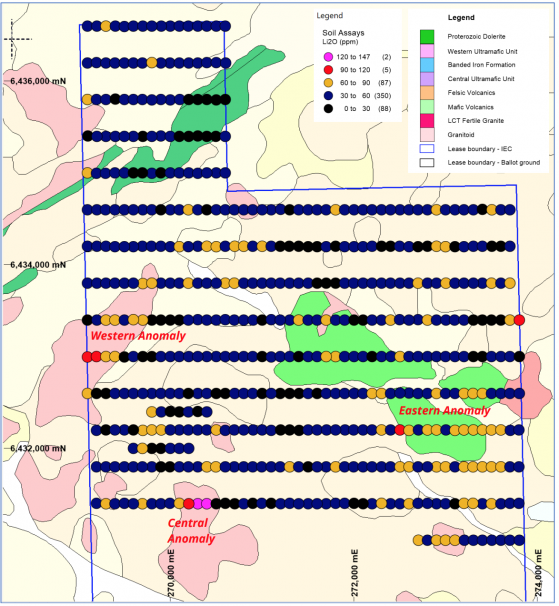Intra Energy Corporation Ltd (ASX:IEC) identified three new lithium anomalies during recently completed soil sampling at the Maggie Hays Hill Project, in the Lake Johnston Greenstone Belt in Western Australia.
These new anomalies extend up to 1,200 metres long and 500 metres wide with values between 60ppm and 147ppm lithium oxide.
Maggie Hays Hill is 25 kilometres north of the Burmeister spodumene deposit held by TG Metals and 25 kilometres northwest of the Medcalf Spodumene deposit held by Charger Metals and Rio Tinto (ASX:RIO).
Intra Energy managing director Ben Dunn said: “We are very pleased with the results of the first part of the soil program at Maggie Hays, which has delineated a series of strong kilometre-long lithium soil anomalies in areas never previously explored.”
“The lithium soil values within these large-scale anomalies are particularly impressive in areas where fertile granites are exposed at surface. Surface alluvial cover obscures the true scale of the anomalism which remains to be more fully evaluated with drilling.”
Exploration ongoing
The soil sampling program was designed to provide first-pass geochemical coverage over the entire tenement for lithium, associated pathfinder elements, gold and base metals.
Surveying was completed on spacing that varied between 400 metres x 100 metres and 200 metres x 100 metres, with a total of 1,286 soil samples collected. An initial 532 results have been reported and resulted in the identification of the three new, large-scale, high-priority lithium anomalies.
The lithium anomalies occur in the northern half of the tenement and the central and eastern lithium anomalies are open to the south.
Northern half of tenement E63/2039 highlighting the strong association between lithium assay results and mapped outcropping granitoids, particularly the western and central granites.
Intra Energy expects the remaining 754 soil assay results back from the lab this month, which will provide further assay information for the southern half of the tenement.
Planning is now underway for a first-pass RC drilling program to test targets and once all results have been received the company will finalise plans for additional exploration and drilling.
In the interim, further fieldwork and mapping will be conducted during March around the lithium anomalies to identify any outcropping pegmatites.
Read more on Proactive Investors AU
